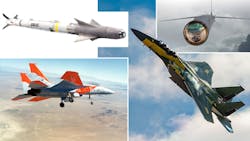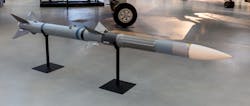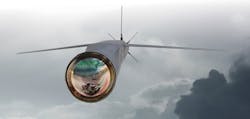Air Force Upgrades the F-15 to the F-15EX Eagle II
The Air Force is upgrading the F-15, which has been flying since 1972, to the F-15EX Eagle II. It will replace aging F-15 Cs and Ds and add to the Air4 Core’s fleet of tactical supersonic jets. The jet, with an estimated cost of around $80 million, will have more computing power, greater maneuverability, more accurate sensors and carry more weapons than the F-15. But it will retain up to 80% of the original F-15 and be able to use to 90% of the same F-15 support equipment.
The F-15EX Eagle being built by Boeing carries an APG-82(V)1 active electronically scanned array (AESA) from Raytheon. It detects, identifies, and tracks several air and surface targets simultaneously at longer ranges.
“Our partnership with the Air Force and Boeing continues on with this historic program,” said Eric Ditmars, vice president of Secure Sensor Solutions at RI&S, who attended the recent unveiling. “Providing our air dominance solutions to the F-15EX ensures successful mission execution and a safe return home.”
The Eagle II can also be equipped with Raytheon’s joint precision approach landing system (JPALS), a military ground-based landing system. It helps the pilot land the aircraft in rugged terrain and low-visibility conditions, and operate despite interference or jamming trying to deny the aircraft valid data.
The fly-by-wire F-15EXs, at least the first eight, will be powered by two F110-GE 129 afterburning turbofan jet engines from General Electric. They are used by several other military aircraft and can generate about 30,000 lb of thrust. Since the engine was first used in 1980, there have been several improvements. For example, GE took data and 3D aerodynamic analysis used on its CFM commercial engines to improve the flow through the engine and upgraded the combustor and high-pressure turbine. All of those improvements lowered the cost-per-flight-hour by 25%, increased the engine’s cycle life by 50% and lengthened the average time-on-wing by a factor of three.
Up until now, Pratt & Whitney engines have been used on every operational F-15 in the U.S. Air Force fleet for more than 40 years. P&W has submitted a proposal to use its F100-PW-229 engine on future F-15EXs. This engine already powers many F-15s and has been successful powering the multi-role, air-to-ground fighters.
The upgraded fighter is a two-seater, though it can be flown and operated by a single pilot with its fly-by-wire flight controls, digital cockpit displays, and advanced avionics.
To compare it to the F-35 Lighting II, the F-35 can carry 22,000 lb of weapons to 50,000 ft and travel 670 miles at a top speed of Mach 1.6. An F-15EX can handle 29,500 lb weapons and fly at 60,000 ft for 1,100 miles at Mach 2.5. The F-35 originally cost $130 million per plane, but costs for the standard A version should eventually be down to around $85 million per plane. And the F-35 runs $35,000 per hour to operate while the F-15EX costs $27,000 per flight hour.
The F15EX can carry an array of weapons, including the AIM-9X Sidewinder, the newest version of the Advanced Medium Range Air-to-Air Missile (AMRAAM), and the new Stormbreaker glide bomb.
The plane can carry up to 6 AIM-9X on its wings, an IR homing missile first made in 1956. The missile used maneuvering fins to steer itself to the target. That was changes to vectored thrust to simplify the controls and make the missile thinner. The $381,000 missile has a range of 22 miles and flies at up to Mach 2.5.
For a look at the latest Sidewinder, check out this video:
The F-15EX can carry up to 12 of the newest version of the AMRAAM missile. It detects, targets and engages enemy aircraft 20 miles away and attacks them at Mach 4. It uses GPS-aided navigation and a two-way data link. The $1.1 million air-to-air missile was first deployed in 1991.
The video below offers a detailed look at the latest AMRAMM Sidewinder.
The bomb can see through fog, smoke and rain as it deploys its wings and glides over 45 miles to strike a moving target. That range goes out to 69 miles for static targets. The bomb has a multimode seeker that combines millimeter wave active radar, semi-active laser guidance, GPS and inertial guidance, and IR homing. The warhead was redesigned during development to provide blast, fragmentation, and armor-piercing shrapnel, making it deadly to tanks, buildings and troops. Depending on the mission, the Eagle II can carry more than 16 of the $227,000 StormBreakers. In 2020, the Air Force cleared the system for use on the F-15E, making it the first aircraft to carry the new weapon.
For more information on the Stormbreaker glide bomb, see the video below:
The Air Force will buy eight of the Boeing built F-15EXs and could eventually buy as many as 144.
The age of the current fleet of F-15C/Ds averages over 37 years, putting many of them at the end of their useful life. According to the Air Force, the F‑15EX is a cost-effective and expedient way to refresh the F‑15C/D fleet and augment the F-15E fleet to meet National Defense Strategy capability and capacity requirements well into the 2040s. They will also help the Air Force maintain aircraft availability despite many of the F-15C/Ds going into service life extension and modernization programs that would take them off the front line.
“This is a big moment for the Air Force,” says Col. Sean Dorey, F-15EX Program Manager. “With its large weapons capacity, digital backbone and open architecture, the F-15EX will be a key element of our tactical fighter fleet and complement 5th-generation assets. In addition, it can carry hypersonic weapons, giving it a niche role in future near-peer conflicts.” For more details on the F-15EX program, see below:




